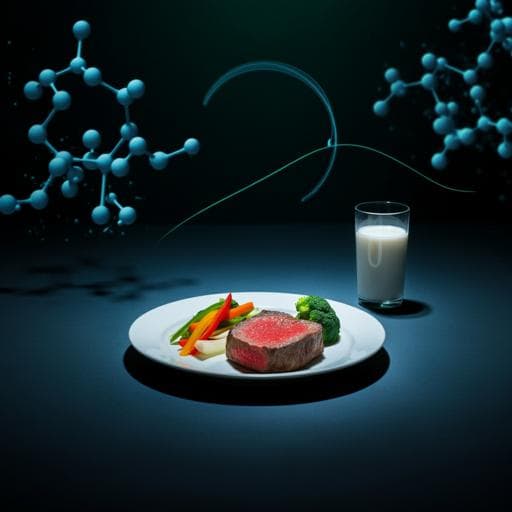
Food Science and Technology
Estimated human intake of endogenous and exogenous hormones from beef in the United States
R. Thilakaratne, R. Castorina, et al.
This groundbreaking study by Ruwan Thilakaratne and colleagues investigates the daily intake of hormonal growth promotants (HGPs) from beef among the US population. While the majority of intake remains low, the highest hazard quotients for melengestrol acetate (MGA) raise concerns—particularly among young boys—highlighting the need for further examination of health risks during sensitive developmental phases.
~3 min • Beginner • English
Introduction
The study investigates human dietary intake of hormonal growth promotants (HGP) from beef in the United States and its potential health implications. HGPs, including both endogenous hormones (e.g., 17β-estradiol and progesterone) and synthetic compounds (e.g., estradiol benzoate, testosterone propionate, trenbolone acetate, zeranol, and melengestrol acetate), are widely used in US beef production to enhance growth and feed efficiency. Residues of these hormones or their active metabolites can persist in edible tissues, leading to human exposure. Hormone exposure is linked to endocrine and reproductive effects, and may influence cancer risk and pubertal timing. Despite widespread beef consumption, comprehensive quantification of usual daily HGP intake in the US population is lacking, and federal monitoring (USDA NRP) has historically been sparse and inconsistent for hormone residues. The study aims to estimate distributions of usual (long-term) and short-term daily intake of selected HGP via beef consumption across age- and sex-defined subgroups, compare intakes to WHO/JECFA acceptable daily intakes (ADIs), and explore potential sociodemographic disparities in intake.
Literature Review
Prior work documents extensive use of HGPs in US feedlots, with surveys indicating high prevalence of implants and oral MGA use. Published measurements of HGP residues in beef are limited and largely from outside the US. The USDA FSIS National Residue Program has historically provided sparse and inconsistent hormone residue data, with limited coverage of HGP (mainly trenbolone acetate, melengestrol acetate, and zeranol). JECFA has established ADIs for some HGP (MGA, testosterone, progesterone) based on toxicological studies, though many studies emphasize adult animals and do not address sensitive developmental windows. Some studies have suggested links between hormone exposures and risks such as hormone receptor-positive breast cancer and altered pubertal timing. Experimental studies have reported MGA residues in beef tissues and higher accumulation in fat. Comparative international studies often report low or non-detectable levels of certain synthetic hormones (e.g., EB, TBA, Z) in retail meats. Endogenous hormones are present in other foods (e.g., dairy), implying that beef-derived estimates represent a portion of total dietary hormone intake.
Methodology
Design: Cross-sectional exposure assessment combining nationally representative dietary recall data (NHANES 2015–2016 and 2017–2018) with laboratory-measured HGP concentrations in retail beef samples from California. Participants: NHANES respondents aged ≥1 year with two 24-hour dietary recalls (24HRs) for usual intake modeling; sex- and age-stratified analyses for children (1–19 years: 1–5, 6–9, 10–19) and adults (20–54, 55+). Beef consumption estimation: Each NHANES food was linked to USDA FNDDS recipes to disaggregate ingredients; beef ingredients identified by keyword matching. Grams of beef consumed were calculated as consumed food weight multiplied by beef fraction in the recipe. Raw beef weight was estimated by dividing cooked beef weight by a moisture adjustment factor of 0.75 to account for cooking moisture loss. Fat versus non-fat proportions were derived from FNDDS nutrition information. Retail beef sampling and analysis: 321 retail beef products were purchased from 59 retailers across four California regions between 2020 and 2022; 76 products were sub-sampled for visible subcutaneous fat, yielding 397 total samples (muscle, fat, organs, ground). Retailers included traditional chains, specialty stores, and limited assortment retailers; cuts prioritized by fat content, affordability, ethnic market availability, and top-selling cuts. Samples were stored at −20 °C and processed using validated UHPLC-MS/MS methods. Tissue extraction used bead beating in phosphate buffer, organic solvent extraction (hexanes/ethyl acetate), drying and reconstitution, followed by UHPLC-MS/MS (Thermo Vanquish Duo UHPLC with Thermo Altis TSQ). Twelve hormones/derivatives were targeted: E2, EB, MGA, P, epitestosterone (EpiT), testosterone (T), TP, trenbolone (TB), TBA, and α-zearalanol. Method validation covered accuracy, precision, recovery, matrix effects, LOD/LOQ, linear range, and stability. Analytes for intake estimation: HGP with ≥10 detections were included with non-detects imputed as LOD/√2. Included: MGA (LOD 0.1 pg/mg; n detections 78), P (LOD 0.5 pg/mg; n=93), T (LOD 0.1 pg/mg; n=22), EpiT (LOD 0.1 pg/mg; n=82). Analytes with <10 detections (e.g., TBA, EB, E2, TP, α-zearalanol, TB) were excluded from intake estimation. Intake scenarios: Three scenarios set assumed HGP concentrations in consumed beef: typical (mean concentration), high (95th percentile), and maximum (highest observed). Concentrations were stratified by fat vs non-fat tissues. Single-day intake calculation: For each 24HR and participant, HGP intake from each beef ingredient was computed as the sum of fat-portion grams times fat concentration plus non-fat grams times non-fat concentration, divided by body weight and scaled to µg/kg/day. Usual intake estimation: The National Cancer Institute (NCI) two-part mixed-effects model was used to estimate usual (long-term) daily intake distributions by subgroup, accounting for episodic consumption. Part 1 (probability) used logistic mixed models; part 2 (amount) used linear mixed models on Box-Cox transformed positive intakes. Covariates included gender, age with linear splines (knots per NHANES design), age×gender interactions, weekday/weekend indicator, and recall sequence. Correlation between parts was allowed. Sampling weights were applied. Monte Carlo simulation generated 100 pseudo-person usual intakes per participant for distributional summaries (mean, median, 95th, 99th percentiles). Comparison to ADIs and HQs: Usual intake distributions were compared to JECFA ADIs for MGA (0.03 µg/kg/day), testosterone (2 µg/kg/day; intake treated as T+EpiT), and progesterone (30 µg/kg/day) via hazard quotients (HQ = intake/ADI). Short-term intake: Two-day average intakes from the two recalls were computed to characterize short-term exposure distributions (days to weeks) and HQs. Sociodemographic analyses: Ratios of median usual MGA intake (typical scenario) were estimated comparing strata of race/ethnicity and poverty status for children (1–19), and race/ethnicity, poverty, and education for adult women (20+), using the NCI method with covariates and balanced repeated replication (32 BRR replicates with Fay’s f=0.3; 30 replicates for women’s education due to convergence). Statistical testing used α=0.05. Additional analyses: Paired fat vs adjacent meat HGP comparisons used Wilcoxon matched-pairs signed-rank tests. Software: SAS 9.4 for NCI modeling; R 4.2.3 for two-day averages and visualization.
Key Findings
- Analytical detections and concentrations in retail beef: Among 76 fat samples, detection frequencies were EpiT 36% (mean 0.20 pg/mg; 95th 0.61; max 3.09), MGA 25% (mean 0.65; 95th 3.25; max 4.07), P 21% (mean 4.91; 95th 48.2; max 70.1), T 4% (mean 0.20; 95th 0.07; max 4.91), TB 1% (one detection). Among 321 non-fat samples, detection frequencies were P 24% (mean 1.84; 95th 9.41; max 26.4), MGA 18% (mean 0.13; 95th 0.40; max 2.38), EpiT 17% (mean 0.10; 95th 0.26; max 1.07), T 6% (mean 0.09; 95th 0.15; max 1.38); trenbolone non-detect across non-fat (imputed LOD/√2). Average concentrations of P (p=0.02), MGA (p<0.01), and EpiT (p<0.01) were higher in fat than adjacent meat.
- Usual (long-term) daily intake versus ADIs: For MGA, no subgroup or scenario exceeded the ADI (0.03 µg/kg/day). Highest estimated usual intake occurred in young boys (1–5 years): 99th percentile under the max scenario 0.0087 µg/kg/day (HQ=0.29). Under the typical scenario, the median for boys 1–5 was 0.00018 µg/kg/day (HQ=0.01). For P, highest usual intake (boys 1–5, 99th percentile, max scenario) was 0.098 µg/kg/day (HQ<0.01) versus ADI 30 µg/kg/day; typical-scenario medians were ≤0.0027 µg/kg/day. For testosterone (T+EpiT), the highest usual intake (boys 1–5, 99th percentile, max scenario) was 0.0092 µg/kg/day (HQ<0.01) versus ADI 2 µg/kg/day.
- Short-term (two-day average) daily intake: For MGA under the max scenario, the 99th percentile equaled the ADI for girls 1–5 (HQ≈1.00) and exceeded it for boys 1–5 (0.036 µg/kg/day; HQ=1.19). Under typical scenario, short-term intakes were far below ADIs across groups. Short-term intakes for P and T were also very low relative to ADIs.
- Demographic patterns: Estimated usual MGA intake under the typical scenario tended to be higher in males and in younger age groups. Non-Hispanic Black women and non-Hispanic Asian children had lower estimated MGA intake than overall women and children, respectively. Trends suggested potentially higher intake among higher-income women, though not statistically significant.
- Overall conclusion regarding safety margins: Usual daily intakes of MGA, P, and T from beef were generally well below their respective ADIs across the population, with the largest relative exposures in young children. Short-term high-end exposures to MGA in young children may approach or exceed the current ADI.
Discussion
The analysis integrates measured HGP concentrations in retail beef with nationally representative consumption data to estimate human intake distributions. Findings indicate that usual daily intakes of MGA, progesterone, and testosterone from beef are substantially below JECFA ADIs across demographic groups, addressing the primary research question by quantifying exposure levels relative to health-based guidance values. However, short-term intakes at the extreme (99th percentile) under the maximum concentration scenario approached or exceeded the MGA ADI in young children, highlighting potential concern for sensitive populations. The study contextualizes results within prior literature, noting that observed concentrations for synthetic hormones like EB and TBA were largely non-detect, suggesting compliance with recommended usage. Elevated concentrations in fat relative to non-fat tissues confirm tissue distribution patterns and underscore the role of beef fat content in intake. The discussion raises critical considerations regarding the derivation of the MGA ADI, which is based on limited-duration, small-sample primate studies centered on adult females, lacking evaluation during sensitive developmental windows. Consequently, while current typical exposures appear safe by prevailing standards, the adequacy of those standards for children is uncertain. Demographic differences in estimated intake likely reflect variations in beef consumption relative to body weight and fat content of consumed beef, with potential implications for health disparities in hormone-sensitive endpoints. The study also notes that beef-derived hormone intake represents only part of total dietary exposure, given contributions from dairy and other sources, implying that overall dietary hormone intake may be higher than estimates from beef alone.
Conclusion
Usual daily intake of melengestrol acetate, progesterone, and testosterone from beef among US children and adults is well below established WHO/JECFA acceptable daily intakes, providing substantial margins of safety under typical consumption scenarios. Nevertheless, short-term high-end exposures to MGA in young children may approach or exceed the current ADI, and existing toxicological data underlying ADIs may not fully capture risks during sensitive developmental periods. Future research should prioritize low-dose, long-term oral toxicity studies of MGA and other HGPs across developmental windows, improved national monitoring of hormone residues in diverse beef cuts and tissues, and comprehensive dietary exposure assessments incorporating dairy and other sources to refine risk evaluations and ensure protection of vulnerable populations.
Limitations
- Retail sampling was non-random and limited to California, potentially limiting generalizability to the broader US beef supply, despite efforts to include diverse regions and retailer types.
- Most samples were non-detect for many HGP, necessitating LOD/√2 imputation; while usual intake estimates remained very low relative to ADIs, finer detection could refine estimates.
- Assumptions in translating NHANES food codes to raw beef intake (e.g., moisture loss factor, retention and consumption of all beef fat) may overestimate intake; conclusions were robust given large safety margins.
- Inability to distinguish beef cuts in NHANES data and limited sample size by cut in retail samples precluded evaluating cut-specific concentration differences; primary contrast was fat vs non-fat.
- Dietary recall data are subject to systematic and random error; while the NCI method accounts for within-person random error, unaddressed systematic biases could affect upper percentile estimates of intake.
- Intake estimates reflect beef-derived hormones only and do not include other dietary sources (e.g., dairy), so total dietary hormone exposure may be underestimated.
Related Publications
Explore these studies to deepen your understanding of the subject.







